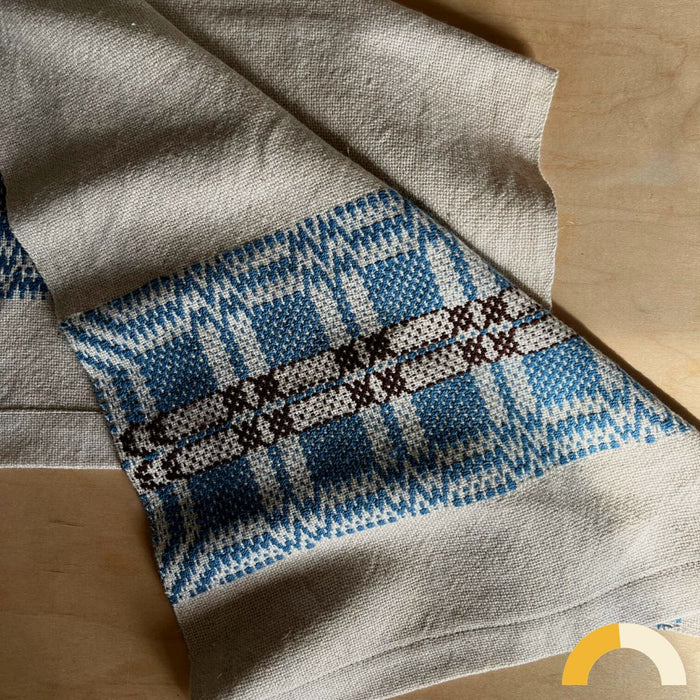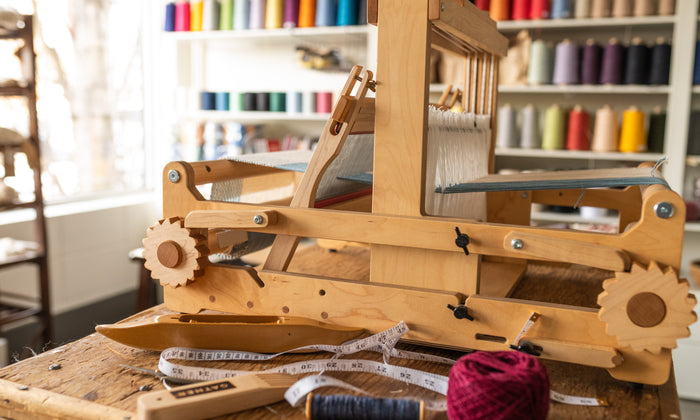‘Beating’ is one of those weaving words that sounds much more dramatic than it really is.
Each time a weaver throws a line (or ‘pick’) of weft, they need to push that weft into place to make a clean and even grid. This is called beating the weft. On a multi-shaft loom, you beat by swinging the beater bar towards you. On a rigid heddle loom, you use the rigid heddle reed to beat the weft. Some styles of weaving, like tapestry weaving and some rug weaving, require a special tool called a hand beater, which is a heavy wooden comb used for heavy beating. The tools are different, but the goal is the same: to get each pick of weft exactly where it needs to be.
 Usually, this requires much less force than the term ‘beating’ implies. With beginners we often talk about ‘placing’ the weft instead, or even ‘kissing’ the weft. If you beat the weft in as hard as you can, the end result will likely be a heavy, stiff piece of weaving. The goal for most plain weave and twill pieces is to achieve a balanced weave, where there are the same number of warp threads and weft threads in a given square inch. Balanced weaving is structurally sound but still drapey, with great stretch in the bias. Instead of cramming as much weft in as possible, aim for balance.
Usually, this requires much less force than the term ‘beating’ implies. With beginners we often talk about ‘placing’ the weft instead, or even ‘kissing’ the weft. If you beat the weft in as hard as you can, the end result will likely be a heavy, stiff piece of weaving. The goal for most plain weave and twill pieces is to achieve a balanced weave, where there are the same number of warp threads and weft threads in a given square inch. Balanced weaving is structurally sound but still drapey, with great stretch in the bias. Instead of cramming as much weft in as possible, aim for balance.
Balance sounds nice, but how do you achieve it? Here are a few strategies. For all of these strategies, be sure to assess your weaving when it is not under tension. Loosen your break a little before checking your beat to make sure that any stretch in the warp isn’t throwing you off.
Look for windows between threads.
Balanced weaving leaves space between each warp end and weft pick. It looks more like a slightly open grid of yarn than like a solid piece of cloth. This can take some getting used to, but don’t worry! Remember that your weaving will come together later once it is off the loom and wet finished (washed). The yarn will full or bloom, and your weaving will shrink slightly. Give your threads breathing room now so that they have space to transform later. When you look down at your weaving on the loom, you should see little empty spaces between your threads. If your weaving is balanced, they should look like little square windows. If they are tall, skinny rectangles instead, you may not be beating hard enough. If they are squashed, fat rectangles, you are likely beating too hard. And if there are no windows at all, you are definitely beating too hard!
Measure your picks per inch.
If you’d like something a little more objective than eyeballing the gaps between your threads, you can always pull out a small ruler and measure your picks per inch (ppi). You have likely learned the term epi (ends per inch) when learning to dress your loom. Epi is a measure of how many warp threads are in each inch of weaving on the loom. Ppi is the same measure, but for the number of weft threads in each one-inch horizontal slice of weaving on the loom. Release your tension, and place the ruler on your weaving. Count the number of weft picks in one inch. Compare this number to the epi of your project. If your ppi count is higher than your epi, you need to lighten up your beat. It can be very helpful to occasionally stop and measure your ppi, especially on a long project, just to make sure that you are not starting to beat harder or softer than you were at the beginning of the warp.
Practice, practice, practice.
...or if you prefer, ‘sample, sample, sample’. The more you weave, the more you will get the feel of a good beat. Beginner weavers often have one of two problems: they beat too hard, or they don’t beat consistently. Pay attention to how your beat impacts your finished cloth. Are you finding your pieces are coming out stiffer than you’d like? Lighten up your beat. Are they coming out a little gauzy, and not firming up well during wet-finishing? You might need to beat harder. Establishing good weaving habits from the beginning will be a huge help for the consistency of your beat. Weaving in the ‘sweet spot’ of your loom--not too close to the heddles, not too close to the breast beam--by advancing your warp regularly is one of the most important things you can do to get a consistent beat. After all, a beater swinging several inches picks up a lot more force than a beater only swinging an inch or two.
As you continue weaving and learning, you may come to a project that requires an unbalanced beat to achieve a specific effect. This certainly isn’t the final word on ‘correct’ beating. But for plain weave and twill, working on a consistent, balanced beat is an important part of weaving good cloth.





